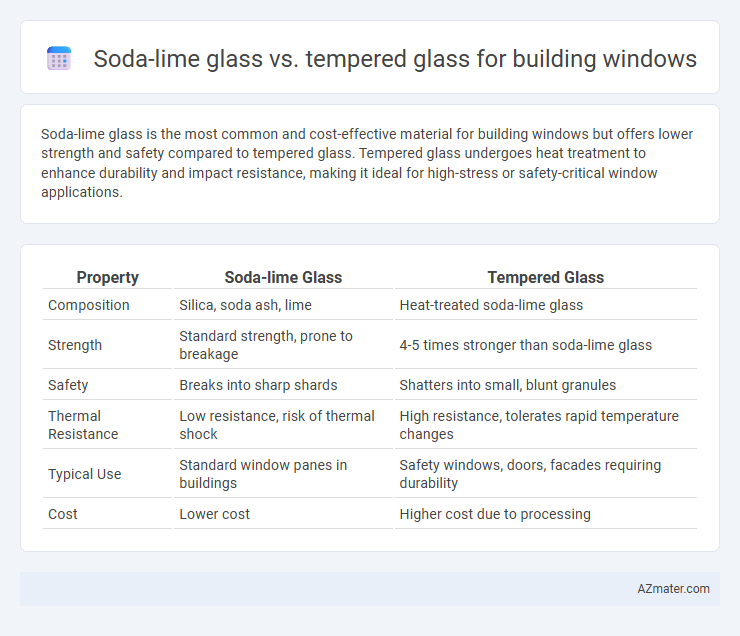Soda-lime glass is the most common and cost-effective material for building windows but offers lower strength and safety compared to tempered glass. Tempered glass undergoes heat treatment to enhance durability and impact resistance, making it ideal for high-stress or safety-critical window applications.
Table of Comparison
| Property | Soda-lime Glass | Tempered Glass |
|---|---|---|
| Composition | Silica, soda ash, lime | Heat-treated soda-lime glass |
| Strength | Standard strength, prone to breakage | 4-5 times stronger than soda-lime glass |
| Safety | Breaks into sharp shards | Shatters into small, blunt granules |
| Thermal Resistance | Low resistance, risk of thermal shock | High resistance, tolerates rapid temperature changes |
| Typical Use | Standard window panes in buildings | Safety windows, doors, facades requiring durability |
| Cost | Lower cost | Higher cost due to processing |
Introduction to Soda-lime Glass and Tempered Glass
Soda-lime glass, the most common type of glass used in building windows, consists primarily of silica, soda, and lime, offering excellent clarity, affordability, and ease of fabrication. Tempered glass, also known as toughened glass, undergoes heat treatment to enhance strength and safety by increasing its resistance to impact and thermal stress. The choice between soda-lime and tempered glass depends on the building's safety requirements, with tempered glass providing superior durability and shatter resistance.
Composition Differences: Soda-lime vs Tempered Glass
Soda-lime glass, primarily composed of silica (SiO2), sodium oxide (Na2O), and calcium oxide (CaO), serves as the base material for most building windows due to its affordability and ease of production. Tempered glass undergoes a thermal or chemical treatment process that alters its internal structure by inducing compressive stresses on the surface and tensile stresses inside, significantly enhancing its strength and safety characteristics. The key composition difference lies in the tempered glass's modified microstructure rather than its elemental makeup, making it more resistant to impact and thermal stress compared to standard soda-lime glass.
Manufacturing Processes of Both Glass Types
Soda-lime glass is produced through a float glass process where molten glass is floated on a bed of molten tin to form flat sheets, which are then annealed slowly to relieve internal stresses. Tempered glass starts as annealed soda-lime glass that undergoes rapid heating to around 620degC followed by immediate quenching with cold air jets to create surface compression and enhance strength. The manufacturing of tempered glass involves precise thermal control and rapid cooling, resulting in a safety glass ideal for building windows due to its higher impact resistance compared to standard soda-lime glass.
Mechanical Strength and Durability Comparison
Tempered glass offers significantly higher mechanical strength than soda-lime glass, with a tensile strength approximately four to five times greater, making it more resistant to impact and thermal stress. Soda-lime glass, commonly used in standard windows, is more prone to breakage due to its lower durability and brittleness under mechanical loads. The enhanced durability of tempered glass ensures greater safety and longevity in building applications where resistance to mechanical forces and temperature fluctuations is critical.
Safety Features: Breakage Behavior
Soda-lime glass shatters into large, sharp shards upon impact, posing significant injury hazards in building windows. Tempered glass undergoes a heat treatment process that causes it to break into small, blunt granules, greatly reducing the risk of cuts and injuries. This safety feature makes tempered glass the preferred choice for building windows requiring enhanced protection against accidental breakage.
Thermal Resistance and Insulation Properties
Soda-lime glass exhibits lower thermal resistance and insulation properties compared to tempered glass, making it less efficient for energy conservation in building windows. Tempered glass provides enhanced strength and better heat resistance, reducing heat transfer and improving thermal insulation. This results in improved energy efficiency and greater comfort within buildings using tempered glass windows.
Cost Analysis: Initial and Long-term Expenses
Soda-lime glass offers a lower initial cost compared to tempered glass, making it a budget-friendly option for building windows. However, tempered glass, though more expensive upfront, provides greater durability and safety, potentially reducing long-term replacement and maintenance expenses. Evaluating the total cost of ownership, tempered glass often proves more cost-effective in high-risk or high-traffic areas due to its enhanced strength and resistance to breakage.
Applications in Building Windows
Soda-lime glass is commonly used in building windows due to its affordability and ease of manufacturing, providing basic transparency and insulation. Tempered glass, favored in safety-critical applications, offers enhanced strength and shatter resistance, making it ideal for high-rise structures and areas prone to impact or extreme weather. Buildings requiring compliance with safety regulations, such as commercial complexes and schools, predominantly utilize tempered glass to ensure occupant protection and durability.
Environmental Impact and Sustainability
Soda-lime glass, the most common type for building windows, has a lower energy footprint during production compared to tempered glass due to its simpler manufacturing process and abundant raw materials like silica, soda ash, and limestone. Tempered glass, while requiring higher energy input to achieve its enhanced strength through heat treatment, offers greater durability and safety, reducing the need for frequent replacements and lowering long-term environmental costs. The improved thermal insulation properties and recyclability of both glass types contribute to sustainable building practices, but tempered glass's longer lifespan often results in a smaller carbon footprint over the building's lifecycle.
Choosing the Right Glass for Your Building Window
Choosing the right glass for your building window depends on factors like safety, durability, and cost. Soda-lime glass is economical and offers basic transparency but lacks strength and impact resistance, making it prone to breakage under stress. Tempered glass provides enhanced safety through increased strength and shatter resistance, ideal for high-traffic or impact-prone areas where building codes require safety glazing.

Infographic: Soda-lime glass vs Tempered glass for Building window
 azmater.com
azmater.com